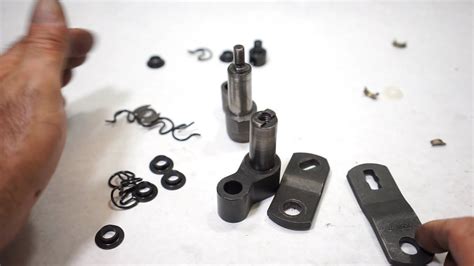Shifter Bushings: The Secret Weapon for a Precise Shift
For car enthusiasts, the feel of a precise, crisp gearshift is akin to a finely tuned instrument. It's a tactile connection to the mechanical heart of your vehicle, enhancing the driving experience significantly. But what happens when that crispness fades? Often, the culprit is worn shifter bushings. These often-overlooked components play a crucial role in transmission feel, and replacing them can dramatically improve your shifting experience. This article delves into the world of shifter bushings, explaining their function, the signs of wear, and the process of replacement.
What are Shifter Bushings?
Shifter bushings are small, cylindrical components made of rubber, polyurethane, or even metal, that act as a buffer between your shifter linkage and the transmission. They're located at various points along the linkage, absorbing vibrations and reducing play in the system. Essentially, they provide a controlled pivot point for the shift lever, ensuring smooth and accurate gear selection. Think of them as tiny shock absorbers for your gearshift. Without functioning bushings, you’ll experience imprecise, sloppy shifts.
Signs Your Shifter Bushings Need Replacing
Several telltale signs indicate that your shifter bushings are worn and need replacing:
- Notchiness or Grinding: A rough, notchy, or grinding feeling when shifting gears is a common symptom. This indicates excessive play in the linkage, causing the shifter to bind or miss its intended position.
- Excessive Play or Sloppiness: If you notice excessive movement or play in the shifter lever, it suggests the bushings have become loose or worn, failing to provide adequate support.
- Missed Shifts: Difficulty selecting gears or accidentally selecting the wrong gear points to worn bushings allowing for imprecise movement.
- Vibrations: Increased vibrations traveling up the shifter lever to your hand can also indicate worn bushings failing to dampen vibrations effectively.
- Shift Lever Movement: If the shifter lever moves excessively in any direction—left, right, or forward and backward—without changing gears, then the bushings are likely failing.
Types of Shifter Bushings
Shifter bushings vary depending on the vehicle make and model. They are typically made from:
- Rubber: These are the most common and are relatively inexpensive, offering decent performance but potentially shorter lifespan.
- Polyurethane: Polyurethane bushings offer increased durability and stiffness compared to rubber, resulting in a firmer shift feel and potentially less movement over time.
- Delrin (Acetal Resin): These are a popular upgrade choice for enthusiasts offering superior durability and precision but are generally more expensive. They provide a very crisp and precise shift feel.
How to Replace Shifter Bushings
Replacing shifter bushings can vary significantly depending on the vehicle's make and model. Always consult your vehicle's repair manual or seek professional assistance if you are unsure about the process. The job may require special tools and a good understanding of your car's mechanics.
Generally, the process involves:
- Disassembling the shifter linkage: This usually entails removing the center console, shifter boot, and possibly some linkage components.
- Removing the worn bushings: This often requires using specialized tools to press out the old bushings.
- Installing the new bushings: New bushings are usually pressed into place, requiring the correct sized press or other tools.
- Reassembling the shifter linkage: This is the reverse of the disassembly process, ensuring everything is correctly aligned and secured.
What are the benefits of replacing worn shifter bushings?
Replacing worn shifter bushings offers several key advantages:
- Improved Shifting Precision: This is the most significant benefit, resulting in crisper, more accurate gear changes.
- Reduced Vibrations: New bushings help absorb vibrations, leading to a smoother and more comfortable driving experience.
- Enhanced Driving Experience: The overall driving feel improves dramatically, contributing to a more engaging and enjoyable ride.
- Extended Transmission Lifespan: By reducing stress on the transmission, well-maintained bushings contribute to a longer service life for the transmission itself.
How much does it cost to replace shifter bushings?
The cost of replacing shifter bushings varies depending on the vehicle, the type of bushings used, and whether the work is done by a professional mechanic or yourself. Parts alone can range from a few dollars to several hundred depending on the vehicle and bushing material, while labor costs could add significantly if you opt for professional installation.
Are there different types of shifter bushings for different driving styles?
Yes, bushing material greatly affects the driving experience. Rubber bushings offer a softer, more forgiving feel, suitable for comfortable daily driving. Polyurethane and Delrin offer a firmer, sportier feel, which is highly desirable for enthusiastic drivers who appreciate a more direct connection to the transmission. The choice depends on your individual preferences and driving style.
Can I replace shifter bushings myself?
While possible, replacing shifter bushings can be challenging, requiring mechanical aptitude and specialized tools. The complexity varies by vehicle. If you lack experience, it's advisable to seek professional help from a qualified mechanic to avoid potential damage. Incorrect installation can lead to further issues.
By addressing worn shifter bushings, you can significantly elevate the driving experience of your vehicle, enjoying a more connected and rewarding feel every time you shift gears. Remember, a small investment in these components can yield a big improvement in driving satisfaction.

